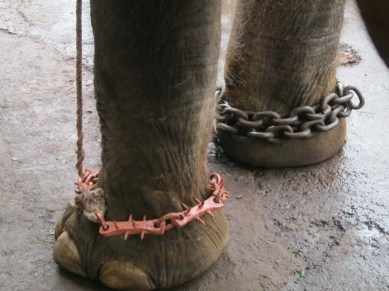📣 For more lifestyle news, click here to join our WhatsApp Channel and also follow us on Instagram
For the Love of an Animal
The story of Mia, Sita and Rhea and why performing animals could do with a happy ending.

Torn from their herd as calves, Mia, Sita, and Rhea have spent most of their lives in chains, shuffling from dark, cramped holding cells to circus stages in Tamil Nadu. Never far from their mahout’s sharp bull hook, these elephants awe audiences with their ability to gracefully pick up performers with their trunks and stand on their hind legs, or even their heads. Spectators sit too far from the stage to notice the red welts on the sisters’ ankles from the chains they wear when not preforming or the limps that each elephant acquired after years of forcefully having to manouever their massive bodies into unnatural positions. “Every move a circus elephant makes on stage is done out of a fear of pain. I find it painfully ironic that Indians worship Ganesha, but treat temple elephants, and all captive elephants, with so much cruelty,” says Prashanth V, head, Federation of Indian Animal Protection Organisation’s (FIAPO) campaign to end circus suffering.
The mission of FIAPO’s campaign is to ban the use of animals in circuses, in particular, elephants. “Most circus elephants were born in the wild, and the spirit of every animal taken from its natural habitat must be broken before it can respond to the demands of a mahout. The mahout’s relationship with the elephant is often romanticised. In reality, every mahout uses negative conditioning to ensure obedience,” he says. “Mahouts often ensure that elephants behave by placing a small stick behind one of their ears,” says Kartick Satyanarayan, co-founder, Wildlife SOS, a Delhi-based NGO that cares for 22 rehabilitated circus and temple elephants in their sanctuaries in Haryana and Uttar Pradesh. “Once the stick is placed, an elephant will stand still for hours knowing that it will be beaten if the stick falls.”
monthly limit of free stories.
with an Express account.
While these elephants interact with humans on a daily basis, they rarely come across other elephants. Consumed by a daily cycle of demand and abuse, they lose their sense of individuality and their capacity to make decisions. Wild elephants spend most of their lives in motion; their size and fast metabolism require them to graze for up to 18 hours a day. Captive elephants, however, spend their days in chains. These animals sway back and forth, bobbing their heads and lifting their feet. “This is called stereotypic behaviour. It is a sign of severe psychological distress. Elephants sway when they have no other way to dissipate their excess energy,” says Dr Gochalan, a veterinarian who supervises the 19 rehabilitated elephants in Wildlife SOS’s Agra sanctuary.
India’s Ministry of Environment, Forests, and Climate Change has two acts that organisations like Wildlife SOS and FIAPO can use to demand the release of captive elephants: the Wildlife Protection Act of 1972 and the Prevention of Cruelty to Animals Act of 1960. These organisations scour the records that elephant owners are required to keep, looking for instances where elephants have crossed state borders without the necessary permit. They also have veterinarians determine whether the elephants are treated with acts of cruelty as defined in the Prevention of Cruelty to Animals Act.
Dr Gochalan confirmed within seconds of meeting Mia, Sita, and Rhea last autumn that they were living in an abusive environment. At the intervention of the ministry, Mia and Sita were rescued in November last year and transferred to Wildlife SOS’s Mathura sanctuary. Rhea was re-united with her sisters last week.
Prahlad Rajvar, their mahout, was also taken to Mathura and taught how to care for the elephants in a more compassionate way. “In the circus, I worked under a man who would tell me which tricks I had to make the elephants perform. Here, the elephants are my boss,” says Rajvar, as he waits for Mia to wake up from a nap so he can bathe her.
For the first time since she was a calf, Mia can sleep lying down. She cracks open one eye and strokes Rhea’s forehead with her trunk every few minutes to make sure her sister is still standing above her.
📣 For more lifestyle news, click here to join our WhatsApp Channel and also follow us on Instagram